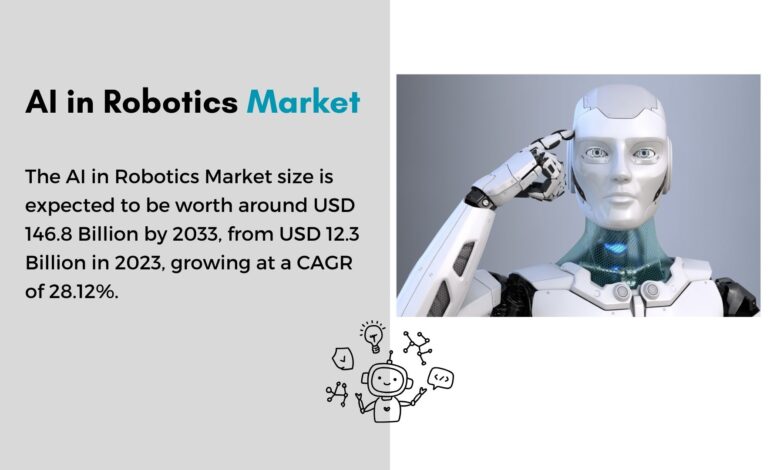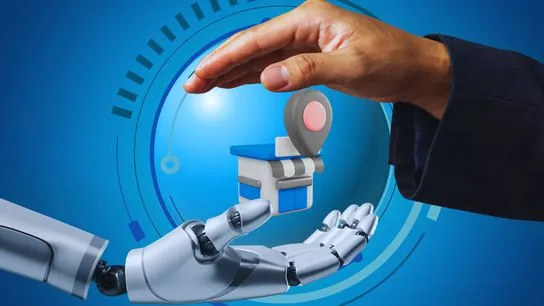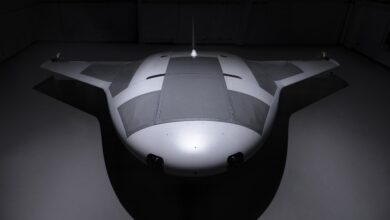AI in Robotics Market to grow by USD 146.8 bn by 2033

Introduction
The global market for AI in robotics is projected to experience significant growth, expanding from USD 12.3 billion in 2023 to an estimated USD 146.8 billion by 2033. This represents a robust compound annual growth rate (CAGR) of 28.12% over the ten-year forecast period from 2024 to 2033.
The expansion of this market can be attributed to several key factors, including advancements in machine learning, increased automation in industries such as manufacturing and healthcare, and the rising demand for precision and efficiency in operations. However, the market faces challenges, such as high initial investment costs, concerns regarding data privacy, and the need for skilled professionals to manage and implement AI technology. These hurdles could impact the pace of adoption and integration of AI in robotics across various sectors.
Key Takeaways
- The global market for AI in robotics is anticipated to experience substantial growth, escalating from USD 12.3 billion in 2023 to an impressive USD 146.8 billion by 2033. This growth represents a robust compound annual growth rate (CAGR) of 28.12% over the forecast period.
- In 2023, the hardware component of AI in robotics maintained a significant lead, securing over 65% of the market share. This segment’s dominance underscores the critical role of physical components in the functioning and enhancement of robotic systems.
- Industrial robots, enhanced with AI capabilities, dominated the market, holding more than 78% of the segment’s share. These robots are integral to the automation processes in industries such as automotive, electronics, and heavy machinery, significantly boosting operational efficiency and productivity.
- Machine learning technology led the advancements in the AI in robotics sector, with a market share exceeding 45%. The adoption of machine learning enhances the adaptability, precision, and efficiency of robots, making them highly valuable in diverse sectors including manufacturing and healthcare.
- The automotive industry heavily relies on AI-driven robotics, holding a dominant share of over 24% in 2023. AI robots perform critical tasks such as welding, painting, and assembly, thereby increasing the precision and speed of automotive production.
- In 2023, North America was at the forefront of the AI in Robotics market, commanding a share of over 41%. The region’s leadership is supported by its advanced technological infrastructure, active governmental initiatives, and the presence of numerous venture capital firms, all contributing to continuous innovation and market expansion.
Emerging Trends
- Increased Adoption of Cloud Robotics: Cloud technology is becoming crucial for robotics, providing robots with enhanced data processing capabilities and the ability to access vast amounts of data from remote servers.
- Advancement in Machine Learning Algorithms: Improvements in machine learning techniques are enabling robots to learn from their environment, improve their operations, and make more complex decisions.
- Expansion of Collaborative Robots (Cobots): Cobots are designed to work alongside humans in a shared workspace without safety cages, increasing efficiency and flexibility in operations.
- Autonomy through AI: Robots are gaining higher levels of autonomy, equipped with AI that allows them to perform tasks independently and interact more naturally with their environment and humans.
- Ethical AI Integration: As AI technology advances, there is a growing focus on developing ethical AI algorithms to ensure robots perform tasks without bias and with respect for privacy and security.
Top 5 Use Cases
- Manufacturing and Assembly: AI-driven robots are being widely adopted in manufacturing for tasks such as assembly, packing, and quality control, offering precision and productivity improvements.
- Healthcare Assistance: In healthcare, robots equipped with AI assist in surgery, patient care, and handling of medical equipment, enhancing the accuracy and patient outcomes.
- Agriculture Automation: AI-enabled robots are used in agriculture for planting, harvesting, and monitoring crops, which increases yield and reduces the need for human labor.
- Logistics and Supply Chain Automation: Robots in logistics optimize warehouse operations, manage inventory, and streamline supply chains by autonomously moving goods.
- Service and Hospitality Robots: In the service sector, AI robots perform various customer service functions, from delivering room service in hotels to providing information at info desks.
Major Challenges
- High Costs of Implementation: The initial investment for integrating AI in robotics can be high, discouraging small and medium enterprises from adopting the technology.
- Skill Gap: There is a significant skill gap in the workforce, as operating and maintaining sophisticated AI-driven robotic systems require advanced technical knowledge.
- Technical Limitations: Despite advances, AI in robotics still faces technical challenges related to decision-making capabilities, sensor integration, and real-time processing.
- Regulatory and Ethical Issues: Navigating the complex regulatory landscape and addressing ethical concerns about automation and job displacement are significant hurdles.
- Integration with Existing Systems: Integrating AI robots into existing infrastructures without disrupting current operations poses logistical and technical challenges.
Recent Developments
- Boston Dynamics and Hyundai Motor Group Collaboration: In August 2022, Boston Dynamics and Hyundai Motor Group announced a commitment of approximately USD 424 million to establish an artificial intelligence research facility in the United States. The Boston Dynamics AI Institute, situated in Cambridge, Massachusetts, aims to advance robotics and AI, focusing on growth-oriented fields.
- Guardforce AI Co., Limited Collaboration: In July 2022, Guardforce AI Co., Limited, a provider of integrated security solutions, entered into a collaboration agreement with the Hong Kong Industrial Artificial Intelligence and Robotics Centre Limited (FLAIR). This collaboration aims to develop robotics-as-a-service (RaaS) solutions and artificial intelligence (AI) cloud platforms globally.
- Brain Corp’s Next-Generation Autonomy Platform: In November 2022, Brain Corp, an AI startup, announced the development of a next-generation autonomy platform for commercial robots. The third-generation AI autonomy platform from Brain Corp, known as BrainOS, powers autonomous commercial robots, facilitating various applications in commercial fields.
Conclusion
The AI in robotics market is experiencing a transformative era, driven by rapid advancements in technology and an expanding range of applications across various industries. The integration of AI enhances the capabilities of robots, making them more autonomous, efficient, and capable of performing complex tasks alongside humans. As trends like cloud robotics, machine learning, and collaborative robots continue to evolve, they are setting the stage for significant innovation and growth in the field.
However, the advancement of AI in robotics also brings forth substantial challenges, including high implementation costs, a widening skills gap, and ongoing technical and ethical dilemmas. Addressing these challenges is critical for the sustainable growth of the AI robotics market and requires concerted efforts from industry stakeholders, policymakers, and educational institutions.



